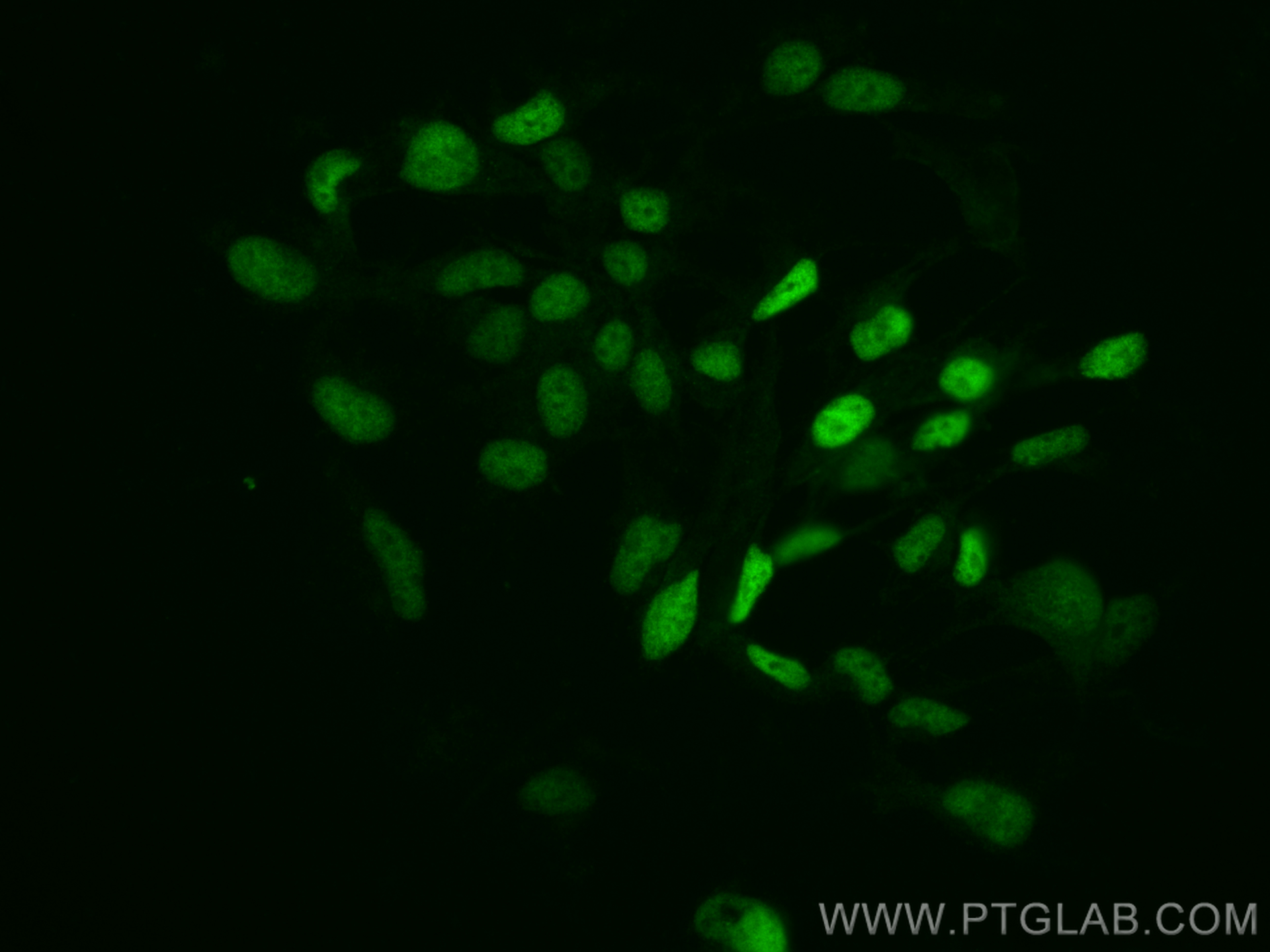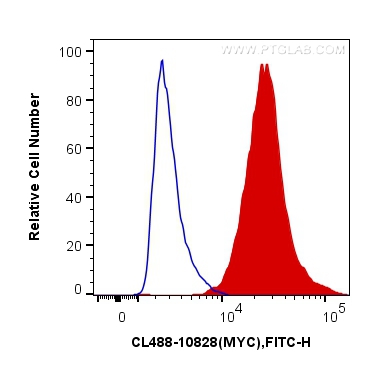- Featured Product
- KD/KO Validated
CoraLite® Plus 488-conjugated c-MYC Polyclonal antibody
c-MYC Polyclonal Antibody for FC (Intra), IF/ICC
Host / Isotype
Rabbit / IgG
Reactivity
human, mouse
Applications
FC (Intra), IF/ICC
Conjugate
CoraLite® Plus 488 Fluorescent Dye
验证数据展示
经过测试的应用
| Positive IF detected in | HEK-293 cells |
| Positive FC detected in | HeLa cells |
推荐稀释比
| Application | Dilution |
|---|---|
| Immunofluorescence (IF) | IF : 1:300-1:1200 |
| Flow Cytometry (FC) | FC : 0.40 ug per 10^6 cells in a 100 µl suspension |
| It is recommended that this reagent should be titrated in each testing system to obtain optimal results. | |
| Sample-dependent, Check data in validation data gallery. | |
产品信息
CL488-10828 targets c-MYC in IF, FC (Intra) applications and shows reactivity with human, mouse samples.
| Tested Applications | FC (Intra), IF/ICC |
| Tested Reactivity | human, mouse |
| Immunogen | c-MYC fusion protein Ag1263 种属同源性预测 |
| Host / Isotype | Rabbit / IgG |
| Class | Polyclonal |
| Type | Antibody |
| Full Name | v-myc myelocytomatosis viral oncogene homolog (avian) |
| Synonyms | bHLHe39, c Myc, c-MYC, MRTL, MYC, Myc proto oncogene protein, Proto oncogene c Myc, Transcription factor p64 |
| Calculated Molecular Weight | 49 kDa |
| Observed Molecular Weight | 62-65 kDa, 50 kDa |
| GenBank Accession Number | BC000141 |
| Gene Symbol | MYC |
| Gene ID (NCBI) | 4609 |
| RRID | AB_2918998 |
| Conjugate | CoraLite® Plus 488 Fluorescent Dye |
| Excitation/Emission Maxima Wavelengths | 493 nm / 522 nm |
| Form | Liquid |
| Purification Method | Antigen affinity purification |
| UNIPROT ID | P01106 |
| Storage Buffer | PBS with 50% Glycerol, 0.05% Proclin300, 0.5% BSA, pH 7.3. |
| Storage Conditions | Store at -20°C. Avoid exposure to light. Aliquoting is unnecessary for -20oC storage. |
背景介绍
Function
c-Myc (also known as Myc), together with l-Myc and n-Myc, belongs to the Myc family of transcription factors. c-Myc has a basic helix-loop-helix leucine zipper domain and through heterodimerization can bind and regulate the transcriptional activity of genes, either by repression or activation. It is a key player in the regulation of cell growth and cell cycle progression and acts as a proto-oncogene.
Tissue specificity
c-Myc is ubiquitously expressed in almost all cell types and its expression positively correlates with tissue proliferative capacity. c-Myc is also expressed during embryogenesis and is upregulated in many cancer types.
Involvement in disease
· Upregulated in many cancer types, especially in aggressive, poorly differentiated tumors.
· Mutations in the MYC gene and breakpoint translocations within the MYC gene cause Burkitt lymphoma.
Isoforms
There are 3 different isoforms of c-Myc: c-Myc1, c-Myc2, and c-MycS (PMID: 16260605). They differ in molecular size, can be preferentially expressed during cell growth, and are reported to be functionally distinct.
Post-translational modifications
c-Myc is subject to various post-translational modifications, including phosphorylation, acetylation, and ubiquitinylation (PMID: 16987807), which regulate its activity.
Cellular localization
c-Myc localizes to the nucleus but can also be present in the cytoplasm of certain cancer types.
实验方案
| Product Specific Protocols | |
|---|---|
| IF protocol for CL Plus 488 c-MYC antibody CL488-10828 | Download protocol |
| FC protocol for CL Plus 488 c-MYC antibody CL488-10828 | Download protocol |
| Standard Protocols | |
|---|---|
| Click here to view our Standard Protocols |


